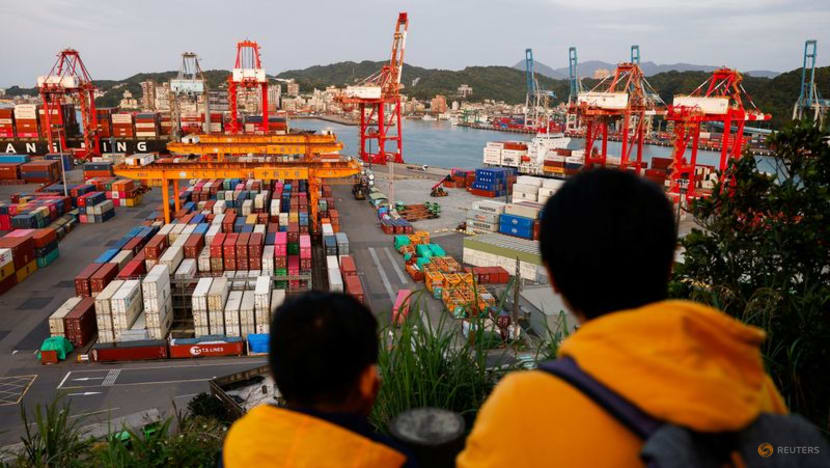Commentary: What Donald Trump’s tariffs might end up doing to Taiwan
Taiwan can little afford Donald Trump’s 32 per cent tariff and China knows that, says J Capital Research’s Anne Stevenson-Yang.

Kids view the area from a lookout point over cranes and containers at the Port of Keelung, Taiwan, on Apr 3, 2025. (Photo: Reuters/Ann Wang)

This audio is generated by an AI tool.
CONNECTICUT: In a face-saving effort, the US administration is now saying that there is strategy driving President Donald Trump’s tariff whiplash - to isolate China, by pausing tariffs on everyone else to cut trade deals.
Isolation, however, is happening to America. China is now looking like the mature statesman at the table, while the US looks like a raging toddler.
Intended to demonstrate dominance, the tariffs on China have instead prompted high anxiety in America, jeering and a search in China for alternative trading partners throughout the world. And Chinese propagandists have shown a surprising new grasp of how public sentiment works.
Memes coming out of the country are genuinely witty: They poke fun that red “Make America Great Again” caps – made in China, unsurprisingly– will now cost more. AI-generated videos feature Americans, even Mr Trump himself alongside adviser Elon Musk, gloomily manufacturing clothes and shoes, pointing out the jobs Americans don’t really want.
What the new tariffs may do, however – even if unintentionally – is make an invasion of Taiwan less likely.
WEAKENING CHINA’S INDUSTRIAL BASE
Antagonism toward China is clear, with the White House saying in a factsheet released Tuesday (Apr 15) that China now faces up to 245 per cent tariff “as a result of its retaliatory actions”. Those tariffs would effectively end trade between the two nations, although Mr Trump had quietly added many exceptions – on smartphones, computers and other electronics – on the evening of Apr 11.
The economic attack on China could mean a weakening industrial complex and a lesser ability to threaten Taiwan militarily.
In part, China’s undemocratic political structure enables defiance in the face of economic pain, and that plays well internationally. The US must react to the public outcry as a falling stock market and rising costs shrink wallets and retirement plans.
Whatever the reasons for China’s strong stance against the US, it appears to be working well, at least diplomatically. On one hand, China has initiated a case against the United States in the World Trade Organization, ironically relying on the institution it formerly undermined, now that the institution’s biggest member has gone rogue. On the other, China has sent senior officials to Europe and Asia seeking trade deals.
Exorbitant tariffs on China, exemptions notwithstanding, hurt more than is suggested by the bravado emerging from Beijing.
The standard economic view is that the US accounted for 14.7 per cent of China's exports in 2024 even if this has been steadily declining, and exports are nearly 20 per cent of China’s gross domestic product, so ending exports to the US could mean as much as a 2.5 per cent hit to GDP before exceptions are taken into account.
But that view seems excessively mechanical. You don't just slice out US$440 billion of trade and go ahead without other disruptions. Whole factories will shut down. Ships will not leave port. The cost of shipping will crash. Prices will drop for oil, iron ore, copper and aluminium. Unemployment will shoot up.
China is already facing declining asset prices, consumer deflation and high unemployment. Industrial profits are down, and foreign direct investment has dropped through the floor. The country has dedicated billions to stimulating consumer demand, without much result.
The added costs and reduced exports, on top of a dangerously stalling economy, could erode the industrial base that supports China’s military by reducing the availability of hard currency to import needed energy and minerals and by lowering the subsidies that the central government directs to military enterprises.
DECIPHERING US INTENTIONS WITH TAIWAN TARIFFS
US intentions toward Taiwan are harder to understand.
Currently on pause for 90 days is a 32 per cent “reciprocal” tariff on all Taiwanese goods. Mr Trump had also threatened to impose a 100 per cent tariff on TSMC, the semiconductor giant seen as Taiwan’s “silicon shield”, if it does not build factories in the US.
Those measures would undermine the island that counts on US support to deter Chinese aggression. Mr Trump had previously refused to say if Washington was committed to defending Taiwan.
Taiwan has said it will not retaliate and has even extended an olive branch. In an op-ed for American media outlet Bloomberg, President Lai Ching-te argued for deeper trade ties with the US and explicitly tied those to security issues.
There are three possible explanations for the threats against Taiwan: ignorance, a shakedown or political theatre.
Not actually knowing the importance of Taiwan’s relationship with the US seems incredible but is possible given the lack of expertise currently in the White House.
The Trump administration has already hinted that tariff exceptions can be purchased. NPR reported last week that Nvidia won an exemption from controls on exporting sensitive chips to China after CEO Jensen Huang attended a US$1 million-a-plate dinner at Mr Trump’s Mar-a-Lago estate.
Perhaps the most likely motive is to demonstrate power and obtain concessions that allow Mr Trump to claim a win.
In anticipation of tariffs, TSMC, which had already committed US$65 billion to build fabrication plants in Arizona, announced it would expand its investment to US$165 billion. Making capital commitments is a familiar strategy for TSMC, and has long been deployed in mainland China. The irony is that its initial investment was made under predecessor Joe Biden’s Chips Act, which Mr Trump said he intends to repeal.
DRIVING TAIWAN INTO CHINA’S EMBRACE?
If Mr Trump’s tariffs were to go into effect, they could drive Taiwan into a tighter embrace with China.
Taiwan can little afford a 32 per cent tariff, and China knows that. Chinese leaders could offer more access to the China market in return for key concessions, perhaps stopping TSMC’s construction in Arizona or agreeing to transfer key technologies that cannot be obtained directly from the United States or Europe.
Most likely, the tariffs on Taiwanese products, or at least on TSMC, will not be implemented, and Mr Trump will find some way to declare victory.
As threatened, the Trump tariffs are a lose-lose-lose proposition for China, Taiwan and the US. If, as expected, the tariffs are reconfigured, the American economy will still suffer, but Taiwan could become that much more secure.
Anne Stevenson-Yang is co-founder of J Capital Research USA LLC, a stock-research company, and author of Wild Ride: A Short History of the Opening and Closing of the Chinese Economy, published in 2024.





















